The master of light and space delivered the remark with a smile. “I have a business of selling blue sky and colored air,” James Turrell ’65 told a group of arts reporters after they had previewed his long-awaited retrospective at the Los Angeles County Museum of Art. But if he counts exhibitions as sales, business is extraordinarily good this year. While Dividing the Light, Turrell’s Skyspace at Pomona College, continues to attract students, alumni and visitors to Draper Courtyard, celebrations of his work are popping up from coast to coast.
The centerpiece of the “Turrell festival,” as LACMA director Michael Govan calls it, is a trio of major museum exhibitions in Los Angeles, Houston and New York. LACMA’s James Turrell: A Retrospective is a five-decade survey, composed of 56 works, including sculptures, prints, drawings, watercolors, photographs and installations. “This is the largest exhibition of works by this artist assembled anywhere at any time,” Govan says. And it will have an unusually long, 10-month run (ending April 6, 2014), so that the expected thousands of visitors can experience the artist’s mind-bending installations as he wishes—slowly, silently, and singly or in small groups. As the museum director reminds guests, “The slower you go, the more you get.”
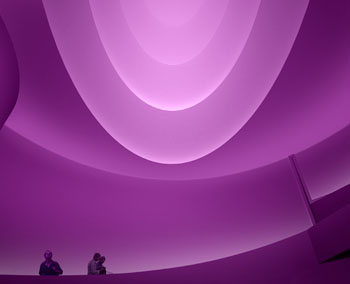
Rendering by Andreas Tjeldflaat. © Solomon R. Guggenheim Foundation
Turrell traces his interest in light to an art history class at Pomona, where he began to see the beam of light emitted by a slide projector as something to look at, not just a means of illuminating something else. As his work evolved, light became his primary material and a path to perceptual discovery. The retrospective follows his career from early light projections in darkened rooms to holograms and “immersive environments” that surround viewers with other-worldly orchestrations of colored light and deceptive space.One large section of the show is devoted to Turrell’s Roden Crater project, which began to take shape in 1977 when the Dia Art Foundation provided funds for the artist to buy a dormant volcano near Arizona’s Painted Desert. With a goal of transforming the crater into an observatory of celestial events and perceptual phenomena, he intended to complete the job around 1990. Challenges of fundraising, engineering and construction have repeatedly extended the project. Now Turrell jokes, “I have said I would finish in the year 2000 and I will stick with that.” He likens himself to a graduate student who can’t seem to complete a doctoral thesis. But his biggest obstacle is the need for an unspecified amount of money, which he concedes is in “the millions.”
Despite persistent delays with Turrell’s magnum opus, the museum exhibitions attest to his productivity in other areas. Over the years, he has made a wide variety of drawings, prints and sculptural pieces related to the crater, as well as installations including floating volumes of projected light, environments that heighten perceptual awareness, and spatially disorienting Ganzfelds. None of his architectural Skyspaces are at the museums because of the difficulty of cutting holes in their walls and ceilings, but he has completed 82 of these structures, each tailored to a specific site. He has also developed Perceptual Cells, designed for one or two people to recline while watching a constantly changing program of phased and strobed light. In the cell at LACMA, called Light Reignfall, a single viewer lies on a narrow bed that slides into a closed chamber.
In Houston, the Museum of Fine Arts has devoted a huge portion of its gallery space to James Turrell: The Light Inside (through Septembber 22). Named for the subterranean installation that connects the museum’s two buildings under a street, the show is entirely drawn from the MFAH’s extensive collection. The museum acquired its first Turrells in the mid-1990s and went on to amass a holding that spans the artist’s career. While some works in the exhibition are familiar to the museum’s core audience, Tycho, a 1967 double-projection, is making its public debut. So is Aurora B, a 2010-11 piece from Turrell’s Tall Glass series, in which LED light is programmed to produce subtle shifts of color on rectangular panels of etched glass over long periods of time.
In New York, the Solomon R. Guggenheim has turned its spectacular rotunda into a Turrell. Called Aten Reign (and scheduled to remain in place until September 25), the installation is billed as “one of the most dramatic transformations of the museum ever conceived.” Turrell has converted the soaring central space of the Frank Lloyd Wright building into an enormous cylindrical volume of fluctuating light, both natural and artificial. Instead of opening to the sky, Skyspace-style, Aten Reign surrounds visitors with concentric lines of glowing color, which lead to the glass-covered oculus at the apex of the historic structure. Adjacent galleries offer more conventional works by Turrell as a complement to the dramatic installation.
The three exhibitions evolved from tentative plans for a traveling retrospective, says Govan, a long-time Turrell associate and former director of the Dia Art Foundation. Leaders of the Los Angeles and Houston museums began a conversation that expanded to include the Guggenheim. “But then we realized that James Turrell exhibitions don’t travel in the typical way because you end up building most of the works on site,” Govan says. The solution was “to do three shows all at once, but with different content.”
Serious Turrellians must see all three, of course. But that isn’t all. Kayne Griffin Corcoran Gallery has opened a new space at 1201 S. La Brea Ave. in Los Angeles, with Turrell’s assistance. The inaugural show of his work has closed, but he has a continuing presence in the gallery’s lighting and a Skyspace, furnished with comfortable chairs. And in Las Vegas, he has designed an installation for The Shops at Crystals, a high-end fashion center that’s encased in an explosive arrangement of angular walls. Turrell’s outdoor spectacle of changing colored light is attuned to the arrivals and departures of trains at the adjacent monorail station.
Govan calls the Los Angeles museum’s show “a little bit of a homecoming” for “a local boy gone good.” Turrell, who was born in L.A. and grew up in Pasadena, is pleased that his work has settled into an exceptionally large chunk of LACMA’s real estate—an entire floor of the Broad Contemporary Art Museum and about a third of the Resnick Pavilion—for an unusually long time. But when reporters and critics question him about his artistic vision, he gets back to his favorite subject: human perception.
“I am very interested in how we perceive because that is how we construct the reality in which we live,” he says. “We all have perception that we have learned. I like to tweak that a little bit, or push you on that. In the Skyspaces, we all know that the sky is blue. We just don’t realize that we give the sky its blueness. We are not very well aware of how much we are part of the making of what we perceive. That’s what I enjoy giving to you. Basically, I have always thought that I use the material, light, to give you perception.”
This summer three major American museums are presenting exhibitions highlighting the achievements of James Turrell ‘65, best known for his large-scale light installations.
LOS ANGELES COUNTY MUSEUM OF ART
James Turrell: A Retrospective
Through April 6, 2014
The first major Turrell retrospective survey gathers approximately 50 works spanning nearly five decades, including his early geometric light projections, prints and drawings, installations exploring sensory deprivation and seemingly unmodulated fields of colored light, and recent two-dimensional holograms. A section is also devoted to Turrell’s masterwork in process, Roden Crater. www.lacma.org
THE MUSEUM OF FINE ARTS, HOUSTON
James Turrell: The Light Inside
Through Sept. 22, 2013
Titled after the museum’s iconic Turrell permanent installation The Light Inside (1999), and centered on the collection of additional work by the artist at the MFAH, the Houston exhibition makes several of the artist’s installations accessible to the public for the first time. www.mfah.org
SOLOMON R. GUGGENHEIM MUSEUM
James Turrell
Through Sept. 25, 2013 Turrell’s first exhibition in a New York museum since 1980 focuses
on the artist’s explorations of perception, light, color and space, with a special focus on the role of site-specificity in his practice. At its core is a major new project that recasts the Guggenheim rotunda as an enormous volume filled with shifting natural and artificial light. www.guggenheim.org
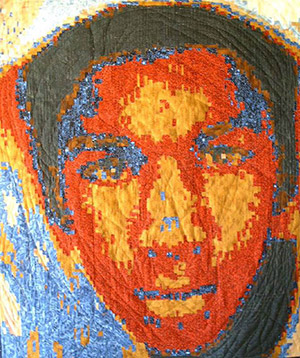 Florida, will be on display at Pomona College, beginning Feb. 23. The quilts come from the Fiber Artists of Hope Network and reveal reactions to Martin’s death in 2012 and hopes for a better America.
Florida, will be on display at Pomona College, beginning Feb. 23. The quilts come from the Fiber Artists of Hope Network and reveal reactions to Martin’s death in 2012 and hopes for a better America.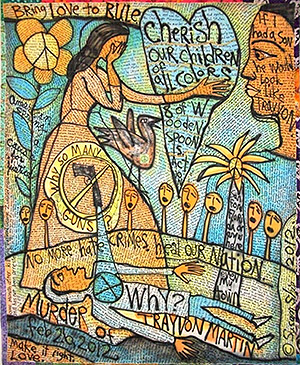
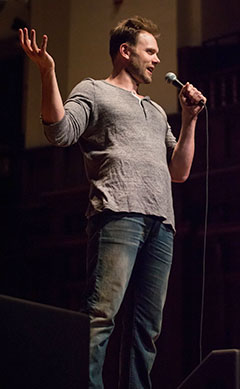 Comedian Joel McHale entertained a packed house of Claremont Colleges students at Little Bridges on Saturday night.
Comedian Joel McHale entertained a packed house of Claremont Colleges students at Little Bridges on Saturday night.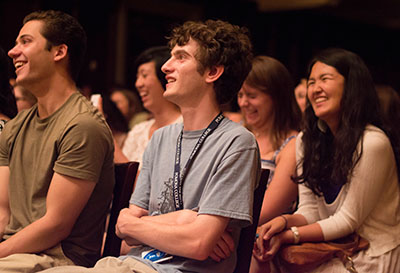
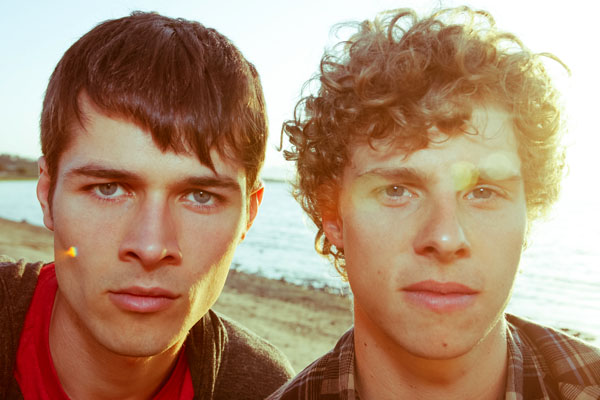


 But paying the musicians required a paying audience. Steve Glass ’57 and subsequently professor of classics at Pitzer College, recalls that early ticket sales for the Brubeck concert were going slowly. His classmate and future wife Sandy was in charge of publicity and she was worried. In those days, West Coast/Cool Jazz was a relatively arcane phenomenon. Then, shortly before the concert, the Nov. 8, 1954 issue of Time magazine had Dave Brubeck on the cover, only the second jazz musician to be so featured (after Louis Armstrong), and the place was packed.
But paying the musicians required a paying audience. Steve Glass ’57 and subsequently professor of classics at Pitzer College, recalls that early ticket sales for the Brubeck concert were going slowly. His classmate and future wife Sandy was in charge of publicity and she was worried. In those days, West Coast/Cool Jazz was a relatively arcane phenomenon. Then, shortly before the concert, the Nov. 8, 1954 issue of Time magazine had Dave Brubeck on the cover, only the second jazz musician to be so featured (after Louis Armstrong), and the place was packed. While visitors hung out and played old records from the station’s still-extensive collection, Tyron noted that some students find working with LPs a tad intimidating because of the direct contact with the surface of the record: “People just get nervous that you’re going to break something.”
While visitors hung out and played old records from the station’s still-extensive collection, Tyron noted that some students find working with LPs a tad intimidating because of the direct contact with the surface of the record: “People just get nervous that you’re going to break something.”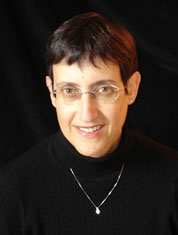 Since then, Paul has carved out an illustrious career in choral conducting and, this month, will return to the Pomona campus as clinician of the 2012
Since then, Paul has carved out an illustrious career in choral conducting and, this month, will return to the Pomona campus as clinician of the 2012